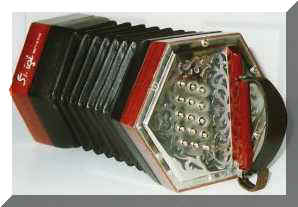![]()
![]()
 This
is the instrument I play.
This
is the instrument I play.
Hope you like it!
It's what we call an "Anglo concertina", which is actually short for "Anglo-German concertina," and it is very popular in Ireland. This particular model is, however, made in Italy.
A real translator's instrument, don't you think?
![]()
There are many types of concertina. However, most of them, including the Anglo concertina, are what we call diatonic instruments. That is, each row of buttons yields a 7-note diatonic scale. Each button produces two notes, one on the press of the bellows, another on the draw. The buttons are "bi-sonoric".
The original English concertina has mono-sonoric buttons, that is, a button produces the same note in both bellows directions. The buttons are arranged in four rows each side, the two middle rows giving the scale of C major and the two outer rows the sharps and flats, so it is relatively easy to read staff notation for the instrument. The body of the English concertina is usually hexagonal, like the Anglo, or eight- or twelve-sided, though square ones do exist.
German concertinas have square-sectioned bodies, unlike the Anglo pictured above. There is another instrument that was developed from the German concertina, and is very similar to it in appearance: the Bandoneon. Many years ago, I purchased one of these dating from around 1900 in an antique shop. It is in very good tune, has a beautiful tone, and I enjoy playing it. This is, however, a solitary pleasure, because my Bandoneon is tuned to the old concert pitch of A=435 Hz. It can only be played together with other instruments that can be re-tuned conveniently.
Here is my Bandoneon (click on the pictures to enlarge them):
Other concertina types coming soon!